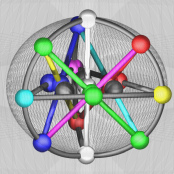



































relational inquiry regarding meaning
_key text inspiring the idea of an integrated encyclopedia
• Hesse, H. (1943) The glass bead game: (Magister Ludi) [R. & C. Winston, trans. Holt, Rinehart and Winston 1969] —For "A General Introduction to [The Game's] Play and Theology," see Jason Giannetti's essay on Medium.com.
This Project addresses the question of meaning in many distinct ways, including the following: 1) as meaning applies to the whole of existence, 2) as meaning applies to 'parts' of existence (as addressed by the Project's phases and nodes), and 3) as meaning applies to our lives in terms of what we might call meaningful experiences. When it applies to the whole exclusively, the question of meaning concerns existence as the very possibility of any experience or meaning whatever. It's this that will always exceed our ability to understand—what we can only witness by way of wonder—and what will always remain a mystery. When meaning applies to the parts of the whole, however—that is, insofar as it applies to our phase-level questions (reality, intelligibility, value, and conditions) plus all their node-level questions—meaning is addressed in terms of how we can make sense of things, and potentially how we can then communicate these various understandings through language. Finally, when meaning applies to our lives in terms of meaningful experiences, we're referring to meaningfulness as a particular quality of those experiences. The following categories of references, then, refer to these various ways of approaching meaning.
• Bishop Robert Barron: "The Mystery of God" —In this YouTube video lecture, Bishop Barron equates God, not with a being, but being itself—a profound mystery.
• Plato quote regarding wonder as the sole and sustaining source of philosophy: from Theaetetus 155d
• Rahner on God as mystery
• Sideris, L. (2022, Oct 4) To benefit from wonder, make sure you've got the genuine kind [Aeon]
• Young, J. (2014) Later Heidegger. In The death of God and the meaning of life 2e, pp. 222-236 [Routledge]
_key texts
• Heidegger, M. (1927) Being and time [J. Macquarrie & E. Robinson, trans. Harper & Row 1962]. Here's an introductory-level presentation showing how Heidegger's ideas as articulated in Being and Time might overlap with this Project's visual language system: "Diagramming Dasein."
• Sheehan, T. (2015) Making sense of Heidegger [Rowman & Littlefield]—presenting Heidegger's phenomenology as "solely and exclusively about meaningfulness and its source" (10).
_phenomenology
• Gallagher, S., & Zahavi, D. (2012) What is phenomenology? In The phenomenological mind 2e, pp. 6-31 [Routledge]
_formal indication
• Dahlstrom, D. O. (1994) Heidegger's method: Philosophical concepts as formal indications [The Review of Metaphysics 47(4), 775-795]
• Inkpin, A. (2016) Phenomenological concepts as formal indication. In Disclosing the world: On the phenomenology of language, pp. 73-81 [MIT Press]—presenting an excellent account of Heideggerian formal indication.
• Morrison, T. (2019) Heidegger's way to the meaning of being [Medium]—offering a more accessible account of formal indication.
• Csikszentmihalyi, M. (1990) Flow: The psychology of optimal experience [Harper Perennial]
• Haidt, J. (2006) The happiness hypothesis: Putting ancient wisdom and philosophy to the test of modern science [Arrow Books]
• Haidt, J. (2010) Finding meaning in vital engagement and good hives. In Wolf, S. Meaning in life and why it matters, pp. 92-101 [Princeton UP]
• Keyes, C. L. M., & Haidt, J., eds. (2003) Flourishing: Positive psychology and the life well-lived [American Psychological Association]
• positive psychology (generally)
Possible analogies/correspondences worth exploring, for purposes ranging from interdisciplinary scholarship to symbol creation:
| domain | fourfold | |||
| 0 | 1 | 2 | 3 | 4 |
| H | I | O | A | L |
| letter meaning/number | hand (or arm+hand)/10 | eye/70 | ox/1 | goad/30 |
| meaning | conceptual | relational | practical | representational |
| philosophy | metaphysics | epistemology | value theory (axiology) | natural philosophy (science) |
| Jung's cognitive functions | thinking | feeling | intuition | sensation |
| Campbell's functions of myth | mystical/metaphysical | cosmological | sociological | pedagogical |
| Heidegger's das Geviert (?) | divinities | sky | mortals | earth |
| יהוה (Tetragrammaton) | י (yod) | ה (he) | ו (vav) | ה (he) |
| (cont.) symbolism | father | mother | son | daughter |
| Kabbalah's four worlds | Atziluth | Bri'ah | Yetzirah | Asiyah |
| Crowley's Magick (tools: roles) | wand: create | cup: preserve | sword: destroy (analyze) | disk: redeem |
| multi-tradition symbolism | seed/germ/sperm | soil/ovum/egg | germination/growth/flowering | fruit |
| classical elements | fire | water | air | earth |
| Platonic solids | tetrahedron | icosahedron | octahedron | cube |
| geometry | vertical axis (1D) | volume (3D) | torus (4D: 3D+time) | horizontal plane (2D) |
| universe (?) | time | space | causality | matter/energy |
